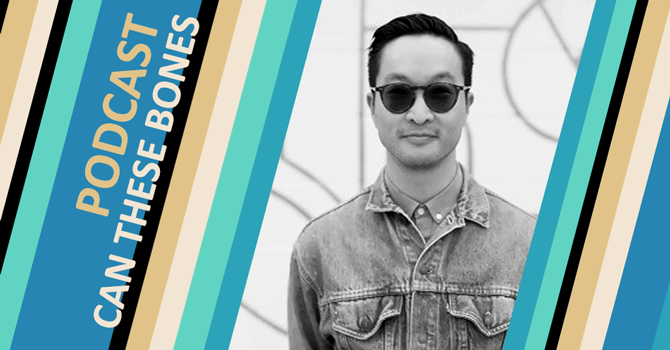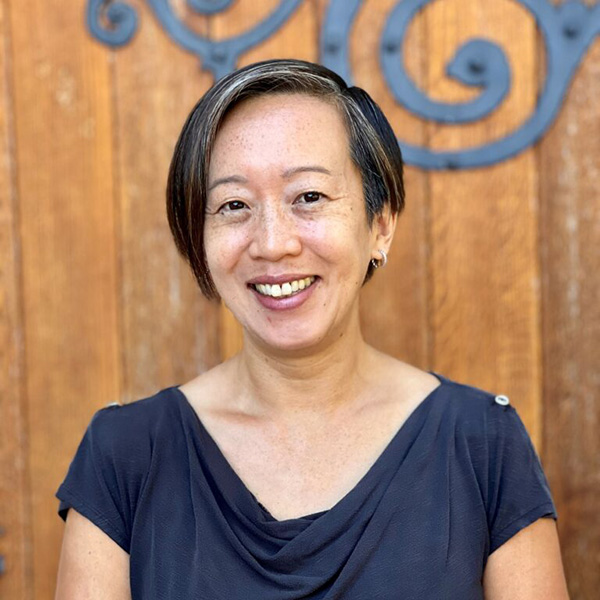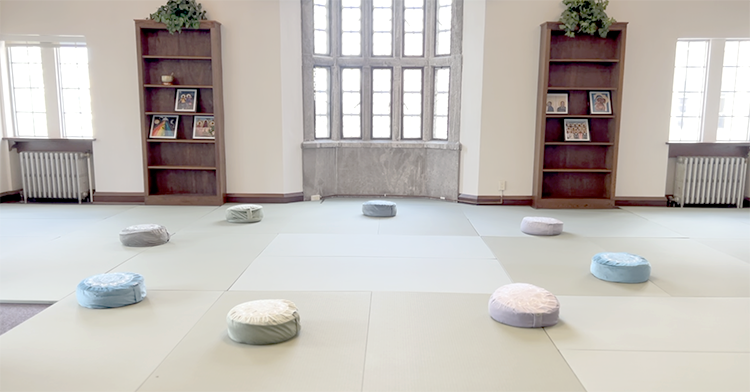On an overcast Sunday morning in April, the sanctuary of Vox Veniae in Austin, Texas, buzzes with young people: filmmakers, artists, musicians and assorted others who typify the city’s creative scene. They are mostly white -- including quintessential hipsters sporting tattoos and vintage clothes -- with a few African-Americans and Hispanics and several Asian-American families mixed in.
They sip locally roasted coffee brewed in the Chemex pour-over system -- taken black, no cream or sugar -- while volunteers hurriedly set up metal folding chairs. The worship space, a renovated former nightclub in East Austin, is a one-story building with a concrete floor, exposed ductwork and elegantly strung Christmas lights. Murals and paintings of Jesus and saints -- made by church members -- line the cinder block walls.

The pastor, the Rev. Gideon Tsang, a trim, tattooed cyclist who looks younger than his 42 years, blends in easily with the flock -- though it’s a far different congregation than the one he started with a decade ago.
When Tsang helped launch Vox in 2006, it was a church plant sponsored by the Austin Chinese Church. Wanting to create a community that better connected with Austin, Tsang and the church set out to capture and reflect the city’s authentic flavor.
“I wanted people when they walk into the church to feel like they’re in Austin,” he said.

Today, the city’s young, quirky, creative vibe clearly pulses through the congregation of about 300. But Vox Veniae is a church constantly grappling with complex issues of identity: What does it mean to be a multiethnic congregation with Chinese immigrant roots? A church that planted itself in a historically black neighborhood that is rapidly being gentrified? A church that, in seeking to reflect its home city, has become mostly white?
What is your church willing to change, or even give up, in order to connect better with the local community?
Tsang concedes that he has far more questions than answers. As he and Vox Veniae negotiate those and other tensions, they try to be a church that serves the entire community, not just the congregation, by sharing space and resources and being good neighbors.
“We sound better on paper than in reality,” he said. “We’re a small, messy little community trying to do our best, live life together, find our vocation and find roots in the city.”
During the week, the sanctuary doubles as a community center, yoga studio, art gallery and office space for several nonprofits. Many church members live in the neighborhood in an effort to be in community with each other and a once-neglected part of Austin.
And as they navigate a shifting landscape, Vox members are finding stability and guidance from an unexpected source -- a denomination. Initially nondenominational, Vox Veniae deliberately sought denominational ties a few years ago, affiliating with the Evangelical Covenant Church, a growing multiethnic denomination founded by 19th-century Swedish Lutheran immigrants.
For Vox Veniae, a church that has welcomed experiment and resisted comfort from the beginning, the journey sometimes feels frustrating and uncertain. But, Tsang said, “There’s beauty in it.”

A church for artists and innovators
Vox Veniae’s story began in 2006 when the Austin Chinese Church, an immigrant congregation founded in 1982, asked Tsang and a few others to start a church that would reach Austin’s young artists and innovators.
The original congregation of 300 to 400 was 99 percent college students and 99 percent Asian, Tsang said. They wanted to find their niche in Austin. But they knew they needed to diversify if they were going to speak to the unique culture of a place widely regarded as one of America’s “coolest” cities.
What is your city’s unique culture? How well does your church reflect it?
In the beginning, leaders sensed that they were going in the wrong direction. The trendy office space they rented near downtown went unused for much of the week. And it felt too comfortable. Something needed to change.
In 2007, after months of prayer, several Vox members moved to a predominantly African-American neighborhood in East Austin.
Separated from the more affluent parts of Austin by Interstate 35, the area bore a grim legacy of racial segregation and neglect, high crime rates and struggling schools. Not exactly a locale where educated, middle-class Asian-Americans intentionally settle. But church members were sure this was where Jesus wanted them to be.
They weren’t there to rescue poor people or to impose what Tsang calls the “evangelical subculture.” The Rev. Harmon Li, Vox’s pastor of worship and liturgy, said the goal was to create a church that felt indigenous to the area.
“We just wanted to be good neighbors,” Li said.
That year, riding his bike along East 12th Street, Tsang stumbled on a vacant building for rent -- a recently shuttered nightclub called Chester’s. The after-hours BYOB bar, which had closed after the fatal shooting of a patron by an Austin police officer, was littered with used condoms and drug needles and needed major renovation. But Vox needed somewhere to worship, and the place was affordable.
Space12
Members of Vox Veniae -- which is Latin for “voice of grace” or “voice of forgiveness” -- are the kind of people who see beauty in broken things, so they worked for months to clean and renovate the building, rechristening it as Space12.

The notion of a church building serving only one purpose once or twice a week seemed wasteful to the pastors. Jesus, they believed, called them to share their resources.
They invited nonprofits, neighborhood and school groups, and artists to use Space12 -- named for the street where it is located -- throughout the week. Inside Books Project, which sends books to Texas prisoners, Allies Against Slavery and other organizations now operate out of the building.
The symbolic renewal of the place felt powerful, Tsang said.
Church members forged community ties individually as well. While many East Austin residents saw the Asian-American newcomers as an oddity at first, Tsang said his new neighbors looked after him. One mowed his lawn while he was out of town. The Tsangs’ young sons made friends with other children in the neighborhood.
But the neighbors did not join Vox, at least not in large numbers. Only about five or six longtime residents from the neighborhood attend the church.
“We knew that the music we play and how I speak isn’t an easy fit for the historic black community,” he said.
Tsang toyed with the idea of making his church more culturally appealing. He considered incorporating hip-hop music into the liturgy or changing his preaching style. But such moves seemed disingenuous.
What factors should a church consider in weighing proposals aimed at becoming more culturally appealing?
The church stayed on the path that felt most natural.
Blending ancient and contemporary
Worship at Vox blends ancient and contemporary traditions. Greek iconography-inspired art, including a painting of the Sacred Heart of Jesus, adorns the walls. Members burn frankincense, receive the Eucharist and pass the peace.
The Rev. Jason Minnix, Vox’s pastor of community and care, said the congregation is “coming back to the historical church through the back door,” reclaiming ancient practices that make the mystery of Christ more accessible.
Much like their approach to the neighborhood, the pastors’ goal with the congregation is not to impose their beliefs on people. Instead, they aim to meet them where they are in their context. And it’s working, members say.
“It was really easy to connect with immediately,” said Alison Boland, a 31-year-old filmmaker, who grew up without religion and joined Vox three years ago. “They talked in vocabulary I could connect with and linked things to secular ideas that I had already been exposed to.”

On a recent Sunday, Tsang’s multimedia homily posed the question, “Can you allow yourself to be loved by God completely?”
With his mellow voice and occasional upward inflection, Tsang sounded like he could be narrating a “This American Life” episode. He read passages from the Gospel, riffed on Mr. T when quoting the apostle Peter, and wove in references to Catholic intellectuals Richard Rohr and Thomas Merton.
He also showed a clip from a 1981 “Mr. Rogers’ Neighborhood” episode in which the late children’s TV host sang “It’s You I Like” to a young boy who had been left quadriplegic after surgery for a spinal tumor.
People wiped tears from their eyes.
The aesthetics and preaching style resonate with young, “right-brained creative” types, Tsang said. Like the rest of the church, most of the black and Hispanic members who worship at Vox are artists or other creative types.
That, if anything, is what sets Vox Veniae apart, he said.
“Our folks -- Latino, black, Asian, white -- are creative,” he said. “We have some multiethnicity, but we’re not that multicultural. The unifying culture is that it feels like Austin.”

Challenges of diversity
Tsang still wishes some of the friends he has made in the neighborhood would join, because he believes their voices “would change who we are.” But he doesn’t force the issue.
The attempt to integrate what the Rev. Martin Luther King famously described as the most segregated hour in America is fraught with challenges, said W. David O. Taylor, a professor of theology and culture at Fuller Theological Seminary and a former Austin pastor.
“To my mind, this desire is at the center of the gospel,” he said. “Yet as many have discovered over the years, it’s not a straightforward affair. It’s hard business, for all sorts of reasons.”
Much depends on particularities of culture, language and other identity-shaping factors, Taylor said. For many, the liturgical style is so important that “to ask [people] to sing or pray or preach otherwise would result in an experience of alienation rather than affirmation.”
Vox’s original members, many of whom grew up in immigrant congregations, are sensitive to those concerns. They understand the need to tell God’s story in culturally specific ways, Tsang said.
Complicating the effort to create a more diverse church is gentrification. Developers were already starting to reshape pockets of East Austin when Vox members relocated there nine years ago. Since then, members have witnessed dramatic transformation as new condos and hip eateries -- along with climbing property taxes -- have displaced longtime residents.
Austin was experiencing staggering growth generally, but nowhere was the population surge felt more acutely than in the historically black enclaves east of the interstate. In the course of a decade, the number of white residents in the neighborhoods east of downtown rose by 40 percent, according to the 2010 U.S. Census, while the African-American population shrank by 27 percent.
Reflecting Austin’s demographic shift
East Austin’s urban neighborhoods have become more homogenous and monocultural, Tsang said.
And Vox’s congregation reflects this demographic shift.
Most of the original Asian-American church members did not make the leap to East Austin in 2007. The church dwindled to 70 members, and when it began to grow again, the newcomers were mostly white.
Five years ago, the congregation was about 40 percent white, 30 percent Asian, and 30 percent black and Hispanic, Tsang said. Today, it’s roughly 60 percent white, 20 percent Asian, 10 percent Hispanic and 10 percent black.
The demographic trend -- both in Vox Veniae and in East Austin -- is a concern for the congregation, which talks openly about diversity. Leaders encourage Vox members to build relationships with their black and Hispanic neighbors outside worship and to be, as Tsang likes to say, “the hands and feet of Christ” in their community throughout the week.
How well does your church serve its surrounding neighborhood? Does it expect anything in return?
“There are definitely conscious efforts to not just be 11 a.m. Sunday people,” said Melissa Martinez, 27, who joined Vox two years ago and now lives within walking distance of Space12.
Vox members partner with neighbors to clean up the local creek and organize neighborhood fairs and safety forums. The church teams with St. James Missionary Baptist, a historic black church, on their annual 5K event for Alzheimer’s research.
If Vox members learn that a neighbor needs help paying a utility bill or covering a home repair, they can tap the church’s Good Neighbor Fund to cover the costs.
Tsang hopes to see more collaboration and more honest dialogue about racial and economic tensions. He realizes this can be a delicate undertaking, especially now that so many Vox members are new to East Austin.
“We’re not going to stop gentrification,” Tsang said. “The only thing we’ve tried to do is humanize it. We try to get people in the same room.”

Finding stability in a denomination
While the church tackles questions of evolving identity -- both in the congregation and in the neighborhood -- Vox leaders have found stability and context within the Evangelical Covenant Church.
Vox aligned with the Chicago-based denomination in 2011 after enduring years of challenge. Tsang said the church was trying to do too much. People -- including himself -- were burning out.
The church was young, small and inexperienced. It needed guidance.
“We wanted to be part of something bigger and older,” he said.
In an age when young adults are eschewing such formal affiliations, Vox members were surprisingly supportive of the move. The denomination connected them with individuals and organizations doing mission work abroad. And the alliance suited their affinity for historic Christian tradition.
“For us, what that means is it connects us to our history and our global significance,” Martinez said. “We are not isolated in Austin; we are part of a bigger picture.”
The ECC gathers a wide range of Christians, including urban multiethnic communities, under its tent -- the diversity Tsang was looking for -- and encourages interaction among the congregations.
ECC congregations represent a mix of theological and political views, too, some of which Vox members don’t agree with.
But that’s part of the challenge of diversity, Tsang acknowledged. And it suits the ethos Vox Veniae has embraced from the beginning.
“It’s not always a comfortable fit for us,” he said. “But I think that’s healthy.”
Questions to consider
Questions to consider
- What is your church willing to change, or even give up, in order to connect better with the local community?
- How could your church building be used more effectively during the week to serve community needs?
- How do you describe your city’s unique culture? How well does your church reflect that culture?
- What factors should a church consider in weighing proposals aimed at becoming more culturally appealing?
- Can an organization’s culture help bridge differences in race and ethnicity? Why or why not?
- How well does your church serve its surrounding neighborhood? What, if anything, does the church expect in return?


















